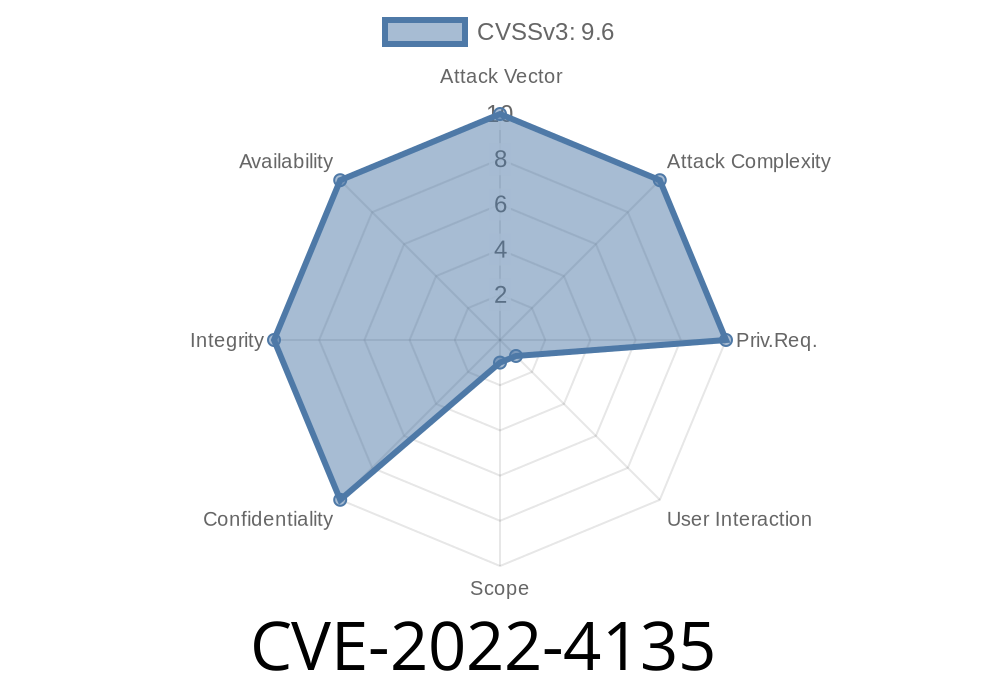Google Chrome, the world’s most popular browser, is no stranger to security exploits. One severe bug, CVE-2022-4135, caught the security community’s eye in late 2022. This vulnerability involved a heap buffer overflow in the GPU component of Chrome and could lead to a sandbox escape. Attackers could potentially exploit this by luring users to a malicious HTML page.
In this post, I’ll break down what CVE-2022-4135 is, how a heap buffer overflow works in this context, how a sandbox escape could be achieved, and provide practical details and code snippets to illustrate the dangers.
Reference:
- Chromium Bug 1384346
- Chrome Release Note
- NVD Entry CVE-2022-4135
What is a Heap Buffer Overflow?
A heap buffer overflow happens when code accidentally (or intentionally) writes more data to a buffer (an array or space in memory) than it was allocated for. On the heap (the part of memory managed dynamically), this can overwrite adjacent data, in this case within Chrome’s GPU process.
Why is this dangerous? If an attacker can control what gets overwritten, they can make the browser execute malicious code or even escalate privileges — in Chrome’s case, escape the highly-protected renderer sandbox.
How Could This Vulnerability Be Exploited?
In Chrome’s multi-process architecture, web content runs in a low-privilege renderer process, while the browser itself and GPU run in higher-privilege processes. If a vulnerability lets code in the renderer process corrupt memory in the GPU process, it could be used to break out of the sandbox.
An attacker would craft an HTML page (possibly with JavaScript and WebGL) exploiting the flaw in the GPU interface. Triggering a heap buffer overflow can let the attacker overwrite function pointers or other critical data, leading to code execution outside the renderer sandbox.
Example Exploit Flow (Simplified)
Let’s walk through a simplified reproduction piece by piece.
Disclaimer: The following is a simplified, educational demonstration and not a weaponized exploit.
Step 1: Create Malicious HTML That Triggers GPU Processing
Chrome’s GPU process handles graphics and WebGL. By crafting specific shaders or issuing unexpected draw calls, it’s possible to trigger code paths that mishandle buffer sizes.
<!DOCTYPE html>
<html>
<head>
<title>CVE-2022-4135 Demo</title>
</head>
<body>
<canvas id="glcanvas" width="256" height="256"></canvas>
<script>
const canvas = document.getElementById('glcanvas');
const gl = canvas.getContext('webgl');
function createOverflowBuffer(gl) {
// Intentionally create large/incorrect buffer sizes
const vertices = new Float32Array(100000); // Unusually large
const buffer = gl.createBuffer();
gl.bindBuffer(gl.ARRAY_BUFFER, buffer);
gl.bufferData(gl.ARRAY_BUFFER, vertices, gl.STATIC_DRAW);
// Triggers processing that could hit the vulnerable GPU code path
gl.drawArrays(gl.TRIANGLES, , vertices.length / 2);
}
createOverflowBuffer(gl);
</script>
</body>
</html>
The code above forces Chrome’s GPU process to handle vast amounts of data, potentially flowing into a buggy buffer handling function.
Step 2: Leverage JavaScript for Memory Spraying
A full exploit would “spray” memory to improve chances of hijacking control over memory layout, but this is omitted here for brevity.
Step 3: Sandbox Escape
If the vulnerability allows, the attacker could overwrite a function pointer or object in the GPU process, triggering arbitrary code execution in a less-restricted context.
Why Was This Bug So Dangerous?
- Renderer-to-browser sandbox escape: Even if you compromise the renderer by visiting a malicious page, Chrome’s multi-process architecture is designed to minimize damage. CVE-2022-4135 makes it possible to break past the separation, affecting the rest of the browser and potentially the entire machine.
- Remote: Can be exploited by simply visiting a web page. No user interaction needed beyond browsing.
- Severity: Google rated this as “High” – it’s not a remote full system exploit alone, but it’s a critical building block for advanced attacks.
Patch and Defense
Google fixed this bug in Chrome version 107..5304.121 and later. If you’re running an older version, you are vulnerable.
> Always keep your browser up-to-date!
- Chrome Download (Latest Version)
- Chrome Release Notes November 2022
Final Thoughts and Takeaways
- CVE-2022-4135 is a real-world crash course in why browser security matters. Heap buffer overflows—especially in GPUs—are notorious for their exploitability.
- Sandboxing works, but bugs like this show it’s not perfect. Browser security relies on layers, but each layer must be solid.
Stay updated, and pay attention to security news.
- If you’re a developer: Learn defensive programming, use tools like AddressSanitizer, and avoid buffer manipulation without bounds checking.
Further Reading and References
- Chromium Vulnerability 1384346
- NVD – CVE-2022-4135
- Understanding Chrome’s Architecture
- Heap Buffer Overflows Explained
Stay safe, surf wisely, and keep your browser patched!
Note: This post is intended for security awareness and educational purposes. Do not attempt to exploit vulnerabilities without authorization.
Timeline
Published on: 11/25/2022 01:15:00 UTC
Last modified on: 11/28/2022 14:44:00 UTC
